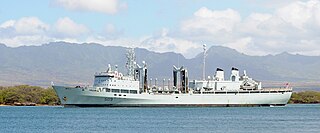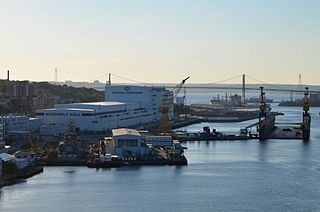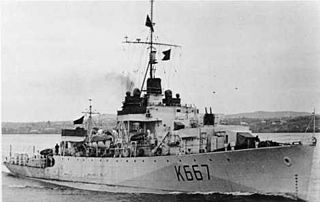
The Royal Canadian Navy is the naval force of Canada. The RCN is one of three environmental commands within the Canadian Armed Forces. As of 2023, the RCN operates 12 frigates, four attack submarines, 12 coastal defence vessels, eight patrol-class training vessels, two offshore patrol vessels, and several auxiliary vessels. The RCN consists of 8,400 Regular Force and 4,100 Primary Reserve sailors, supported by 3,800 civilians. Vice-Admiral Angus Topshee is the commander of the Royal Canadian Navy and chief of the Naval Staff.
The Protecteur-class auxiliary oiler replenishment (AOR) ships were used by the Royal Canadian Navy to resupply ships at sea with food, munitions, fuel and spare parts. They had more sophisticated medical and dental facilities than smaller warships. At 172 metres (564 ft) the ships were some of the largest operated by the RCN. Entering service in 1969, the last vessel of the class was paid off in 2016.

HMCS Calgary is a Halifax-class frigate that has served in the Canadian Forces and Royal Canadian Navy since 1995. Calgary is the sixth vessel in her class and the second vessel to carry the designation HMCS Calgary. She was built as part of the Canadian Patrol Frigate Project. Calgary began the FELEX refit in June 2012. She is assigned to Maritime Forces Pacific (MARPAC) and is homeported at CFB Esquimalt. Calgary serves on MARPAC missions protecting Canada's sovereignty in the Pacific Ocean and enforcing Canadian laws in its territorial sea and exclusive economic zone.

HMCS Algonquin was an Iroquois-class destroyer that served in the Royal Canadian Navy (RCN) from 1973 to 2015.

HMCS Preserver was a Protecteur-class auxiliary oiler replenishment of the Royal Canadian Navy commissioned in 1970. Built at Saint John, New Brunswick and launched in 1969, the vessel took part in several overseas deployments, including Operation Deliverance, which became better known as the Somalia Affair. The ship underwent a major refit in 2005, after she was plagued by electrical problems. With these difficulties unresolved, Preserver was withdrawn from sea-going service in 2014 and was paid off on 21 October 2016. The vessel was broken up for scrap at Sydney, Nova Scotia in 2017.

Her Majesty's Canadian Ship (HMCS) Protecteur was the lead ship of the Protecteur-class replenishment oilers in service with the Royal Canadian Navy. She was part of Maritime Forces Pacific (MARPAC), homeported at CFB Esquimalt, British Columbia. Built by Saint John Shipbuilding and Dry Docks in Saint John, New Brunswick, she was commissioned on 30 August 1969. She was the first Canadian naval unit to carry the name Protecteur; however, there have been several units, including a base, named HMCS Protector.

The Type 702 Berlin-class replenishment ship is a series of replenishment ships, originally designed and built for service in the German Navy. Designed to support United Nations overseas missions, the Berlin class were initially to number four vessels. However, three hulls were cut from the initial order. The lead ship, Berlin, began construction in 1999 and entered service in 2001. The second hull, Frankfurt am Main, was re-ordered in 1998, began construction in 2000 and entered service in 2002. The third hull, Bonn, was ordered in 2008 to a modified design, began construction in 2010 and entered service in 2013. All three ships are in service and are based at Wilhelmshaven.
The Protecteur class of naval auxiliaries for the Royal Canadian Navy (RCN) began as the Joint Support Ship Project, a Government of Canada procurement project for the RCN that is part of the National Shipbuilding Procurement Strategy. It will see the RCN acquire two multi-role vessels to replace the earlier Protecteur-class auxiliary oiler replenishment vessels.

Davie Shipbuilding is a shipbuilding company located in Lauzon, Quebec, Canada. The facility is now operating as Chantier Davie Canada Inc. and is the oldest continually operating shipbuilder in North America.

HMCS Penetang was a River-class frigate that served in the Royal Canadian Navy from 1944 to 1945 during the Second World War. She fought in the Battle of the Atlantic as a convoy escort. She was recommissioned and served as a Prestonian-class frigate from 1954 to 1956. She was named for Penetanguishene, Ontario.

The Halifax Shipyard Limited is a Canadian shipbuilding company located in Halifax, Nova Scotia.

HMCS Charlottetown was a River-class frigate that served with the Royal Canadian Navy (RCN) during the Second World War. She was the second vessel of the name, HMCS Charlottetown having been a Flower-class corvette that had been sunk earlier in the war. They are unique for being the only two ships to have shared the same pennant number, K 244. She was named for Charlottetown, Prince Edward Island.

USNS Andrew J. Higgins (T-AO-190) was a Henry J. Kaiser-class oiler of the United States Navy which saw active service from 1987 to 1996. Sold to Chile in 2009, she was commissioned as Almirante Montt in the Chilean Navy in 2010.

Harry DeWolf-class offshore patrol vessels are warships of the Royal Canadian Navy (RCN) built within the Government of Canada Arctic and Offshore Patrol Ship (AOPS) procurement project, part of the National Shipbuilding Strategy. In July 2007 the federal government announced plans for acquiring six to eight icebreaking warships for the RCN.

HMCS Inch Arran was a River-class frigate that served with the Royal Canadian Navy during the Second World War and again from 1954 to 1965, when she was converted into a Prestonian-class frigate. She was named after Inch Arran Point in Dalhousie, New Brunswick, Canada. This was due to the inability of two Allied warships to bear the same name. The RCN would then use landmarks or significant areas that were associated with the community instead.
The National Shipbuilding Strategy (NSS), formerly the National Shipbuilding Procurement Strategy (NSPS), is a Government of Canada program operated by the Department of Public Works and Government Services. The NSS was developed under the Stephen Harper Government in an effort to renew the fleets of the Royal Canadian Navy (RCN) and the Canadian Coast Guard (CCG). The strategy was broken into three sections; the combat package, the non-combat package and the smaller vessel package. The companies who won the bids for the larger ships were not permitted to bid on the smaller vessel package. In 2019 the Trudeau Government decided to add a third shipyard to the NSS specializing in the construction of icebreakers for the Coast Guard. The agreement to incorporate Davie as a third shipyard within the NSS was finally signed in April 2023.

Project Resolve is the name of a pan-consortium made up of Chantier Davie Canada, Aecon Pictou Shipyard of Pictou, Nova Scotia and NavTech, a naval architectural firm, to develop an interim fleet supply vessel for the Royal Canadian Navy (RCN) until the previously-ordered Protecteur-class auxiliary vessels are complete. As of 2016, the project purchased MS Asterix, a commercial container ship, and is converting the vessel into an auxiliary naval replenishment ship that will be rented by the Royal Canadian Navy. The conversion was expected to be completed and the ship active in service by 2017. In late 2017, Davie proposed extending the project through the conversion of a second ship to ensure full capability for both the Atlantic and Pacific fleets.

HMCS Harry DeWolf is the lead ship of its class of offshore patrol vessels for the Royal Canadian Navy (RCN). The class was derived from the Arctic Offshore Patrol Ship project as part of the National Shipbuilding Procurement Strategy and is primarily designed for the patrol and support of Canada's Arctic regions. Named after Vice Admiral Harry DeWolf, a former head of the RCN, the vessel was ordered in 2011, laid down in 2016 and launched in 2018. The vessel completed contractors sea trials in July 2020, was delivered to the RCN on 31 July 2020 and began post-acceptance sea trials. Harry DeWolf was commissioned on 26 June 2021.

HMCS Margaret Brooke is the second Harry DeWolf-class offshore patrol vessel for the Royal Canadian Navy (RCN). The class was derived from the Arctic Offshore Patrol Ship project as part of the National Shipbuilding Procurement Strategy and is primarily designed for the patrol and support of Canada's Arctic regions. Named after Sub-Lieutenant Margaret Brooke, an RCN nursing sister who tried to save another person during the sinking of the ferry SS Caribou during World War II. Margaret Brooke was ordered in 2011, laid down in 2016 and launched in 2019. The vessel began contractor sea trials in May 2021, and it was delivered to the Royal Canadian Navy for post-acceptance sea trials on 15 July 2021. The official naming ceremony for the ship was conducted on 29 May 2022 in conjunction with that for sister ship Max Bernays. The vessel was commissioned on 28 October 2022.

















